Business Environment Analysis: Primark, Sectors, and Stakeholders
VerifiedAdded on 2019/12/04
|28
|8822
|174
Report
AI Summary
This report provides a comprehensive analysis of Primark's business environment, examining various aspects such as its stakeholders, including investors, employees, lenders, suppliers, customers, financial institutions, and the public. It also delves into different sectors like public, charity, and cooperative sectors, comparing Primark with companies such as Tesco, NSPCC, and Baywind Energy Co-operative. The report further investigates Primark's organizational responsibilities, including operational systems, economic systems in the UK, and the significance of international trade to UK business organizations. It explores the impact of global factors and the policies of the European Union on UK business organizations, providing a detailed overview of the company's operations, objectives, and its response to various market forces and environmental factors. The report covers a wide range of factors, including market structures, pricing, and the influence of cultural and business environments on organizational behavior.
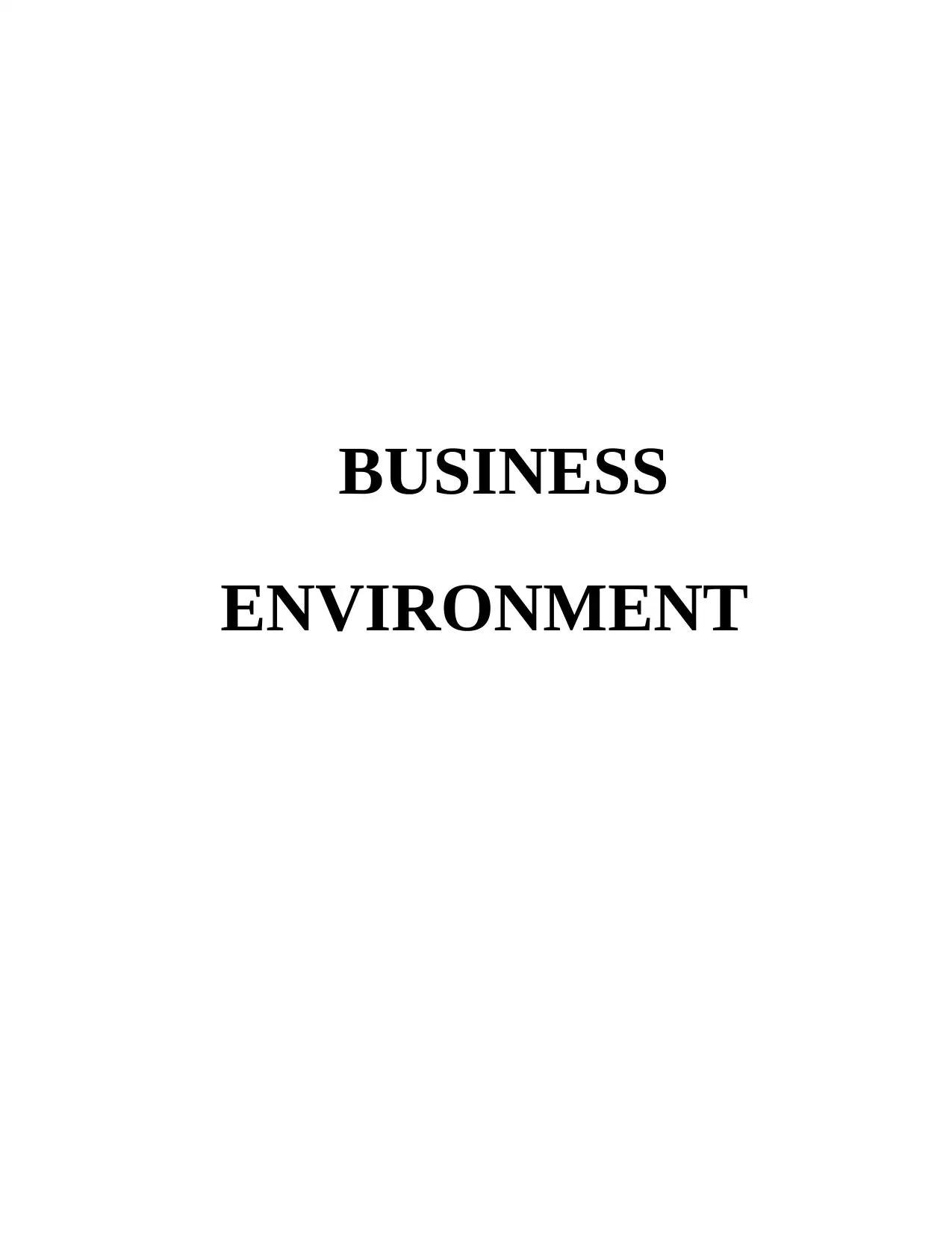
BUSINESS
ENVIRONMENT
ENVIRONMENT
Paraphrase This Document
Need a fresh take? Get an instant paraphrase of this document with our AI Paraphraser
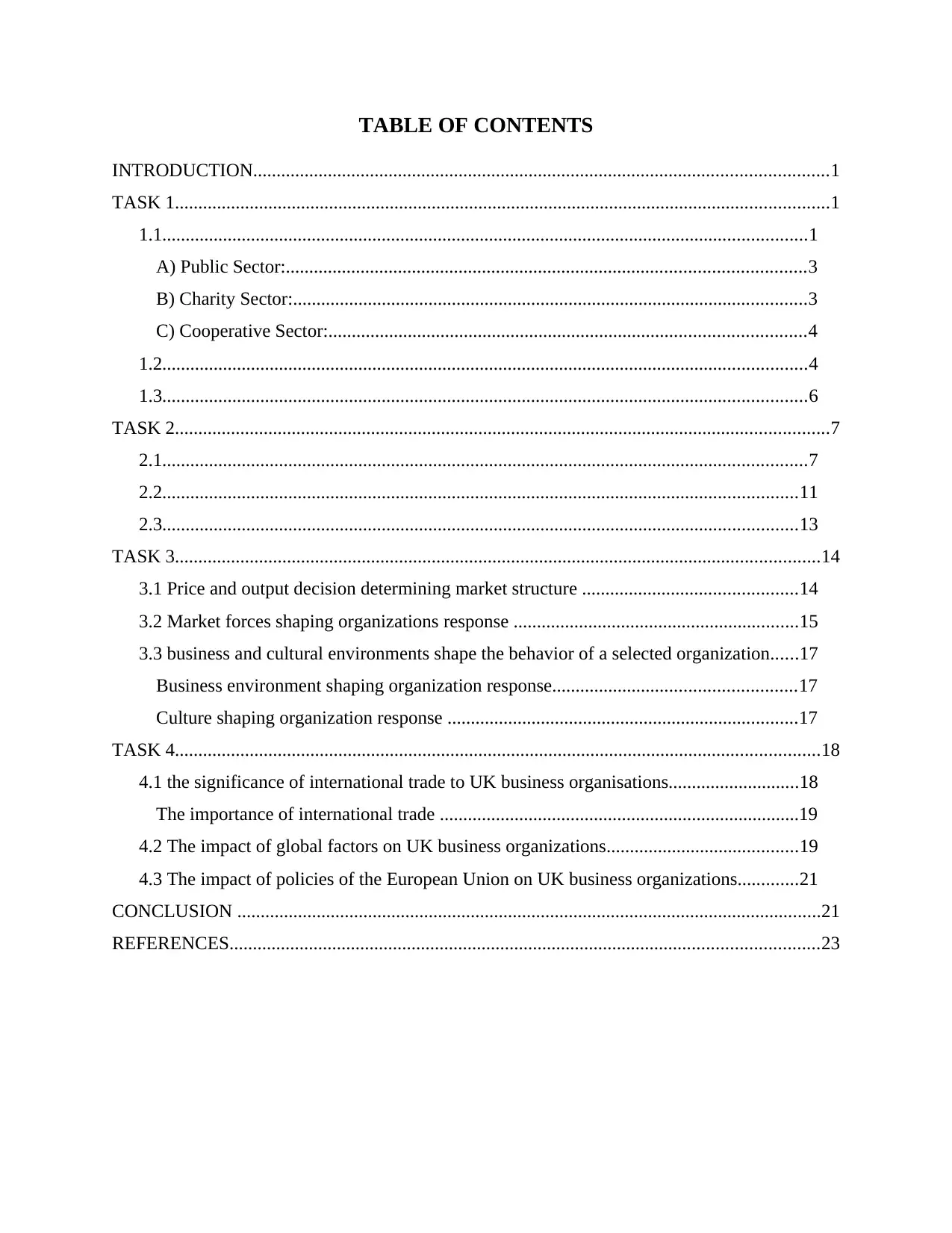
TABLE OF CONTENTS
INTRODUCTION...........................................................................................................................1
TASK 1............................................................................................................................................1
1.1..........................................................................................................................................1
A) Public Sector:...............................................................................................................3
B) Charity Sector:..............................................................................................................3
C) Cooperative Sector:......................................................................................................4
1.2..........................................................................................................................................4
1.3..........................................................................................................................................6
TASK 2............................................................................................................................................7
2.1..........................................................................................................................................7
2.2........................................................................................................................................11
2.3........................................................................................................................................13
TASK 3..........................................................................................................................................14
3.1 Price and output decision determining market structure ..............................................14
3.2 Market forces shaping organizations response .............................................................15
3.3 business and cultural environments shape the behavior of a selected organization......17
Business environment shaping organization response....................................................17
Culture shaping organization response ...........................................................................17
TASK 4..........................................................................................................................................18
4.1 the significance of international trade to UK business organisations............................18
The importance of international trade .............................................................................19
4.2 The impact of global factors on UK business organizations.........................................19
4.3 The impact of policies of the European Union on UK business organizations.............21
CONCLUSION .............................................................................................................................21
REFERENCES..............................................................................................................................23
INTRODUCTION...........................................................................................................................1
TASK 1............................................................................................................................................1
1.1..........................................................................................................................................1
A) Public Sector:...............................................................................................................3
B) Charity Sector:..............................................................................................................3
C) Cooperative Sector:......................................................................................................4
1.2..........................................................................................................................................4
1.3..........................................................................................................................................6
TASK 2............................................................................................................................................7
2.1..........................................................................................................................................7
2.2........................................................................................................................................11
2.3........................................................................................................................................13
TASK 3..........................................................................................................................................14
3.1 Price and output decision determining market structure ..............................................14
3.2 Market forces shaping organizations response .............................................................15
3.3 business and cultural environments shape the behavior of a selected organization......17
Business environment shaping organization response....................................................17
Culture shaping organization response ...........................................................................17
TASK 4..........................................................................................................................................18
4.1 the significance of international trade to UK business organisations............................18
The importance of international trade .............................................................................19
4.2 The impact of global factors on UK business organizations.........................................19
4.3 The impact of policies of the European Union on UK business organizations.............21
CONCLUSION .............................................................................................................................21
REFERENCES..............................................................................................................................23
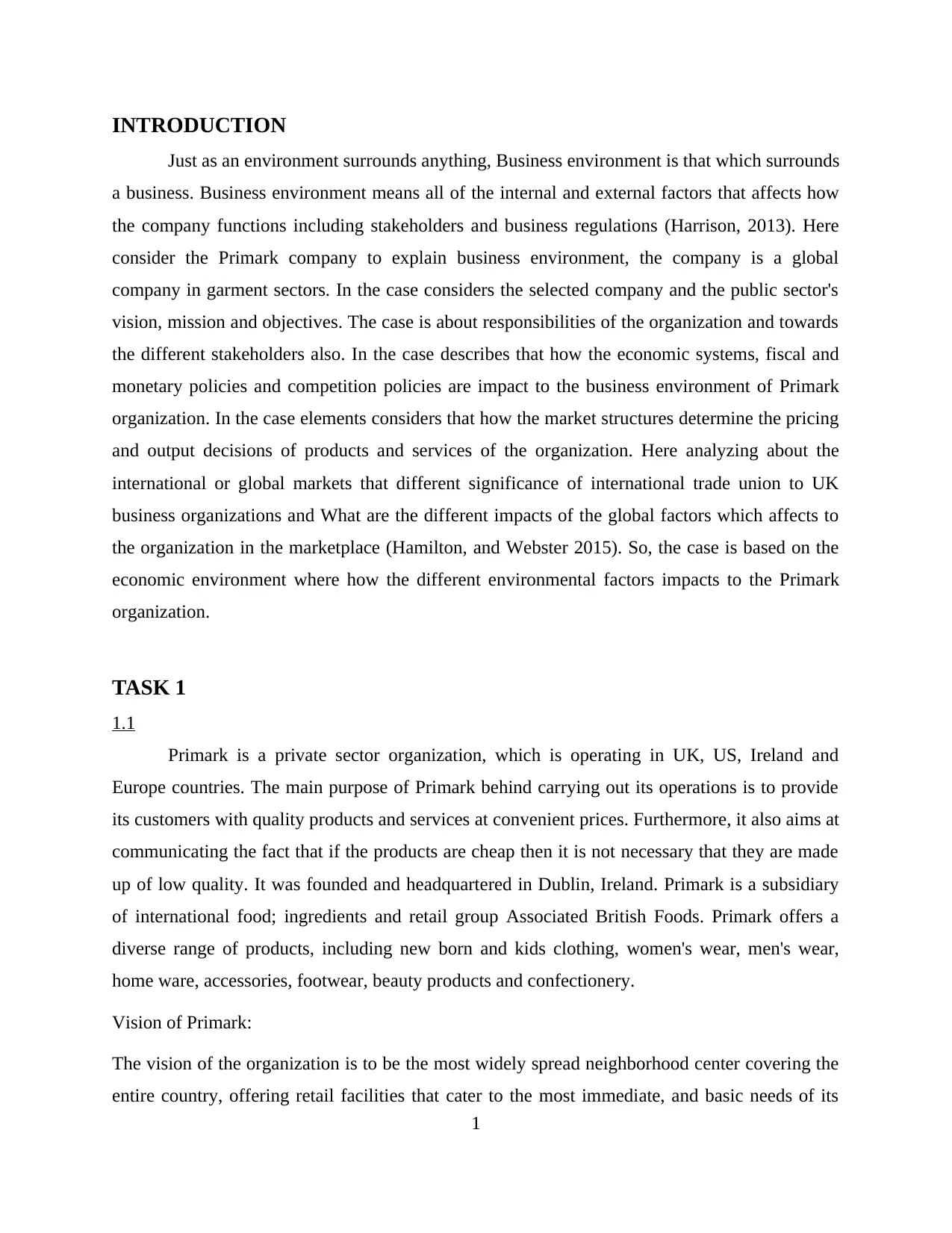
INTRODUCTION
Just as an environment surrounds anything, Business environment is that which surrounds
a business. Business environment means all of the internal and external factors that affects how
the company functions including stakeholders and business regulations (Harrison, 2013). Here
consider the Primark company to explain business environment, the company is a global
company in garment sectors. In the case considers the selected company and the public sector's
vision, mission and objectives. The case is about responsibilities of the organization and towards
the different stakeholders also. In the case describes that how the economic systems, fiscal and
monetary policies and competition policies are impact to the business environment of Primark
organization. In the case elements considers that how the market structures determine the pricing
and output decisions of products and services of the organization. Here analyzing about the
international or global markets that different significance of international trade union to UK
business organizations and What are the different impacts of the global factors which affects to
the organization in the marketplace (Hamilton, and Webster 2015). So, the case is based on the
economic environment where how the different environmental factors impacts to the Primark
organization.
TASK 1
1.1
Primark is a private sector organization, which is operating in UK, US, Ireland and
Europe countries. The main purpose of Primark behind carrying out its operations is to provide
its customers with quality products and services at convenient prices. Furthermore, it also aims at
communicating the fact that if the products are cheap then it is not necessary that they are made
up of low quality. It was founded and headquartered in Dublin, Ireland. Primark is a subsidiary
of international food; ingredients and retail group Associated British Foods. Primark offers a
diverse range of products, including new born and kids clothing, women's wear, men's wear,
home ware, accessories, footwear, beauty products and confectionery.
Vision of Primark:
The vision of the organization is to be the most widely spread neighborhood center covering the
entire country, offering retail facilities that cater to the most immediate, and basic needs of its
1
Just as an environment surrounds anything, Business environment is that which surrounds
a business. Business environment means all of the internal and external factors that affects how
the company functions including stakeholders and business regulations (Harrison, 2013). Here
consider the Primark company to explain business environment, the company is a global
company in garment sectors. In the case considers the selected company and the public sector's
vision, mission and objectives. The case is about responsibilities of the organization and towards
the different stakeholders also. In the case describes that how the economic systems, fiscal and
monetary policies and competition policies are impact to the business environment of Primark
organization. In the case elements considers that how the market structures determine the pricing
and output decisions of products and services of the organization. Here analyzing about the
international or global markets that different significance of international trade union to UK
business organizations and What are the different impacts of the global factors which affects to
the organization in the marketplace (Hamilton, and Webster 2015). So, the case is based on the
economic environment where how the different environmental factors impacts to the Primark
organization.
TASK 1
1.1
Primark is a private sector organization, which is operating in UK, US, Ireland and
Europe countries. The main purpose of Primark behind carrying out its operations is to provide
its customers with quality products and services at convenient prices. Furthermore, it also aims at
communicating the fact that if the products are cheap then it is not necessary that they are made
up of low quality. It was founded and headquartered in Dublin, Ireland. Primark is a subsidiary
of international food; ingredients and retail group Associated British Foods. Primark offers a
diverse range of products, including new born and kids clothing, women's wear, men's wear,
home ware, accessories, footwear, beauty products and confectionery.
Vision of Primark:
The vision of the organization is to be the most widely spread neighborhood center covering the
entire country, offering retail facilities that cater to the most immediate, and basic needs of its
1
⊘ This is a preview!⊘
Do you want full access?
Subscribe today to unlock all pages.

Trusted by 1+ million students worldwide
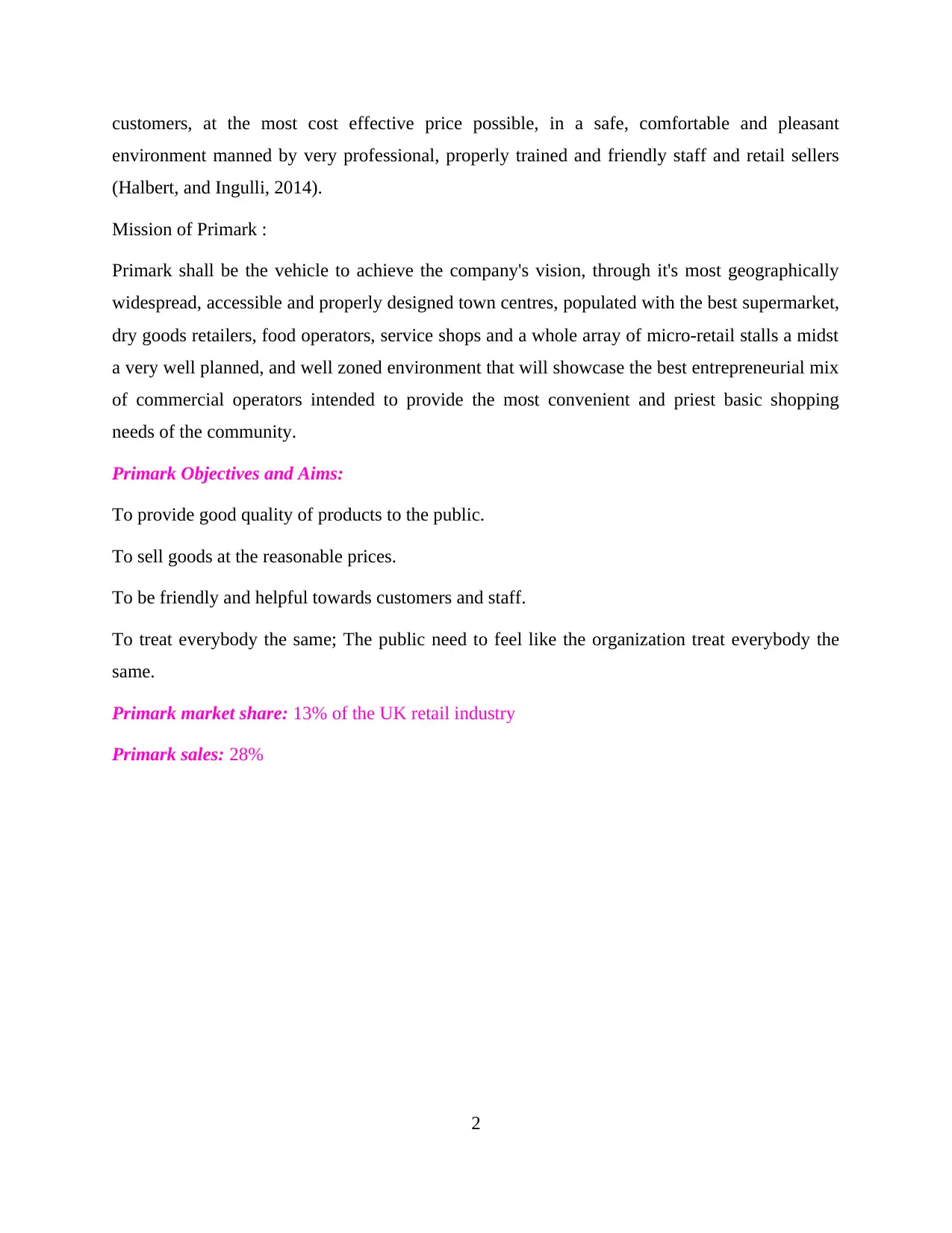
customers, at the most cost effective price possible, in a safe, comfortable and pleasant
environment manned by very professional, properly trained and friendly staff and retail sellers
(Halbert, and Ingulli, 2014).
Mission of Primark :
Primark shall be the vehicle to achieve the company's vision, through it's most geographically
widespread, accessible and properly designed town centres, populated with the best supermarket,
dry goods retailers, food operators, service shops and a whole array of micro-retail stalls a midst
a very well planned, and well zoned environment that will showcase the best entrepreneurial mix
of commercial operators intended to provide the most convenient and priest basic shopping
needs of the community.
Primark Objectives and Aims:
To provide good quality of products to the public.
To sell goods at the reasonable prices.
To be friendly and helpful towards customers and staff.
To treat everybody the same; The public need to feel like the organization treat everybody the
same.
Primark market share: 13% of the UK retail industry
Primark sales: 28%
2
environment manned by very professional, properly trained and friendly staff and retail sellers
(Halbert, and Ingulli, 2014).
Mission of Primark :
Primark shall be the vehicle to achieve the company's vision, through it's most geographically
widespread, accessible and properly designed town centres, populated with the best supermarket,
dry goods retailers, food operators, service shops and a whole array of micro-retail stalls a midst
a very well planned, and well zoned environment that will showcase the best entrepreneurial mix
of commercial operators intended to provide the most convenient and priest basic shopping
needs of the community.
Primark Objectives and Aims:
To provide good quality of products to the public.
To sell goods at the reasonable prices.
To be friendly and helpful towards customers and staff.
To treat everybody the same; The public need to feel like the organization treat everybody the
same.
Primark market share: 13% of the UK retail industry
Primark sales: 28%
2
Paraphrase This Document
Need a fresh take? Get an instant paraphrase of this document with our AI Paraphraser
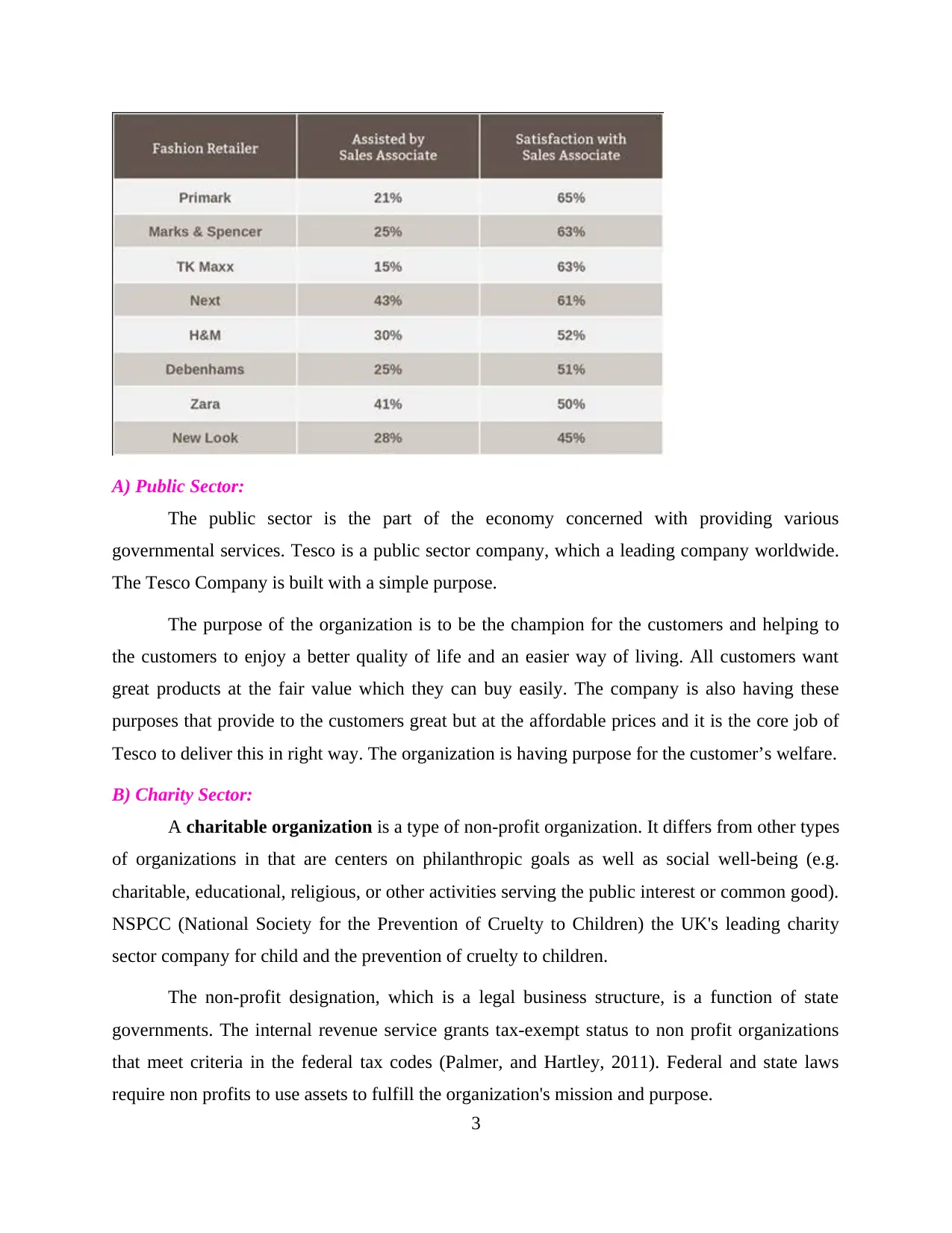
A) Public Sector:
The public sector is the part of the economy concerned with providing various
governmental services. Tesco is a public sector company, which a leading company worldwide.
The Tesco Company is built with a simple purpose.
The purpose of the organization is to be the champion for the customers and helping to
the customers to enjoy a better quality of life and an easier way of living. All customers want
great products at the fair value which they can buy easily. The company is also having these
purposes that provide to the customers great but at the affordable prices and it is the core job of
Tesco to deliver this in right way. The organization is having purpose for the customer’s welfare.
B) Charity Sector:
A charitable organization is a type of non-profit organization. It differs from other types
of organizations in that are centers on philanthropic goals as well as social well-being (e.g.
charitable, educational, religious, or other activities serving the public interest or common good).
NSPCC (National Society for the Prevention of Cruelty to Children) the UK's leading charity
sector company for child and the prevention of cruelty to children.
The non-profit designation, which is a legal business structure, is a function of state
governments. The internal revenue service grants tax-exempt status to non profit organizations
that meet criteria in the federal tax codes (Palmer, and Hartley, 2011). Federal and state laws
require non profits to use assets to fulfill the organization's mission and purpose.
3
The public sector is the part of the economy concerned with providing various
governmental services. Tesco is a public sector company, which a leading company worldwide.
The Tesco Company is built with a simple purpose.
The purpose of the organization is to be the champion for the customers and helping to
the customers to enjoy a better quality of life and an easier way of living. All customers want
great products at the fair value which they can buy easily. The company is also having these
purposes that provide to the customers great but at the affordable prices and it is the core job of
Tesco to deliver this in right way. The organization is having purpose for the customer’s welfare.
B) Charity Sector:
A charitable organization is a type of non-profit organization. It differs from other types
of organizations in that are centers on philanthropic goals as well as social well-being (e.g.
charitable, educational, religious, or other activities serving the public interest or common good).
NSPCC (National Society for the Prevention of Cruelty to Children) the UK's leading charity
sector company for child and the prevention of cruelty to children.
The non-profit designation, which is a legal business structure, is a function of state
governments. The internal revenue service grants tax-exempt status to non profit organizations
that meet criteria in the federal tax codes (Palmer, and Hartley, 2011). Federal and state laws
require non profits to use assets to fulfill the organization's mission and purpose.
3
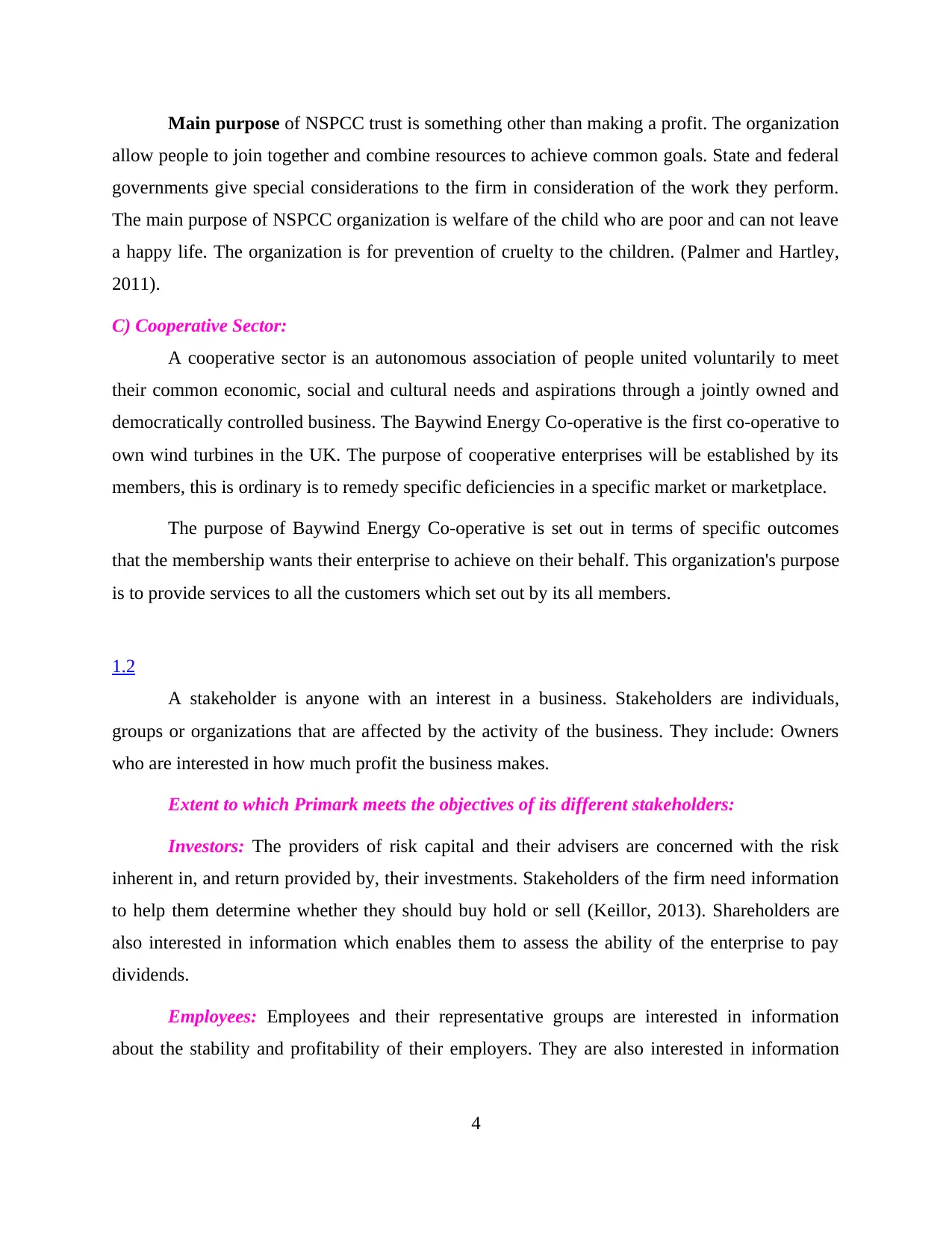
Main purpose of NSPCC trust is something other than making a profit. The organization
allow people to join together and combine resources to achieve common goals. State and federal
governments give special considerations to the firm in consideration of the work they perform.
The main purpose of NSPCC organization is welfare of the child who are poor and can not leave
a happy life. The organization is for prevention of cruelty to the children. (Palmer and Hartley,
2011).
C) Cooperative Sector:
A cooperative sector is an autonomous association of people united voluntarily to meet
their common economic, social and cultural needs and aspirations through a jointly owned and
democratically controlled business. The Baywind Energy Co-operative is the first co-operative to
own wind turbines in the UK. The purpose of cooperative enterprises will be established by its
members, this is ordinary is to remedy specific deficiencies in a specific market or marketplace.
The purpose of Baywind Energy Co-operative is set out in terms of specific outcomes
that the membership wants their enterprise to achieve on their behalf. This organization's purpose
is to provide services to all the customers which set out by its all members.
1.2
A stakeholder is anyone with an interest in a business. Stakeholders are individuals,
groups or organizations that are affected by the activity of the business. They include: Owners
who are interested in how much profit the business makes.
Extent to which Primark meets the objectives of its different stakeholders:
Investors: The providers of risk capital and their advisers are concerned with the risk
inherent in, and return provided by, their investments. Stakeholders of the firm need information
to help them determine whether they should buy hold or sell (Keillor, 2013). Shareholders are
also interested in information which enables them to assess the ability of the enterprise to pay
dividends.
Employees: Employees and their representative groups are interested in information
about the stability and profitability of their employers. They are also interested in information
4
allow people to join together and combine resources to achieve common goals. State and federal
governments give special considerations to the firm in consideration of the work they perform.
The main purpose of NSPCC organization is welfare of the child who are poor and can not leave
a happy life. The organization is for prevention of cruelty to the children. (Palmer and Hartley,
2011).
C) Cooperative Sector:
A cooperative sector is an autonomous association of people united voluntarily to meet
their common economic, social and cultural needs and aspirations through a jointly owned and
democratically controlled business. The Baywind Energy Co-operative is the first co-operative to
own wind turbines in the UK. The purpose of cooperative enterprises will be established by its
members, this is ordinary is to remedy specific deficiencies in a specific market or marketplace.
The purpose of Baywind Energy Co-operative is set out in terms of specific outcomes
that the membership wants their enterprise to achieve on their behalf. This organization's purpose
is to provide services to all the customers which set out by its all members.
1.2
A stakeholder is anyone with an interest in a business. Stakeholders are individuals,
groups or organizations that are affected by the activity of the business. They include: Owners
who are interested in how much profit the business makes.
Extent to which Primark meets the objectives of its different stakeholders:
Investors: The providers of risk capital and their advisers are concerned with the risk
inherent in, and return provided by, their investments. Stakeholders of the firm need information
to help them determine whether they should buy hold or sell (Keillor, 2013). Shareholders are
also interested in information which enables them to assess the ability of the enterprise to pay
dividends.
Employees: Employees and their representative groups are interested in information
about the stability and profitability of their employers. They are also interested in information
4
⊘ This is a preview!⊘
Do you want full access?
Subscribe today to unlock all pages.

Trusted by 1+ million students worldwide
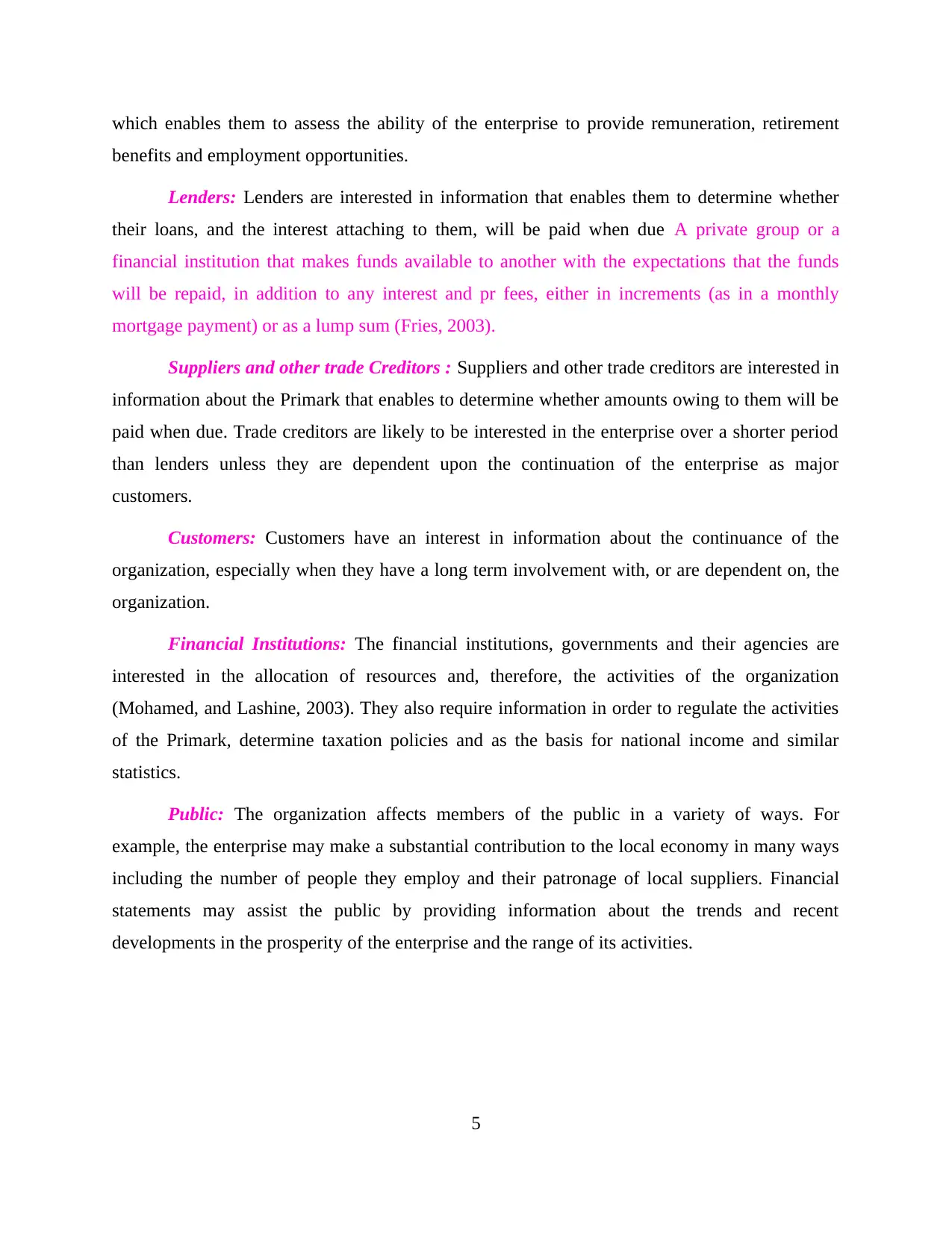
which enables them to assess the ability of the enterprise to provide remuneration, retirement
benefits and employment opportunities.
Lenders: Lenders are interested in information that enables them to determine whether
their loans, and the interest attaching to them, will be paid when due A private group or a
financial institution that makes funds available to another with the expectations that the funds
will be repaid, in addition to any interest and pr fees, either in increments (as in a monthly
mortgage payment) or as a lump sum (Fries, 2003).
Suppliers and other trade Creditors : Suppliers and other trade creditors are interested in
information about the Primark that enables to determine whether amounts owing to them will be
paid when due. Trade creditors are likely to be interested in the enterprise over a shorter period
than lenders unless they are dependent upon the continuation of the enterprise as major
customers.
Customers: Customers have an interest in information about the continuance of the
organization, especially when they have a long term involvement with, or are dependent on, the
organization.
Financial Institutions: The financial institutions, governments and their agencies are
interested in the allocation of resources and, therefore, the activities of the organization
(Mohamed, and Lashine, 2003). They also require information in order to regulate the activities
of the Primark, determine taxation policies and as the basis for national income and similar
statistics.
Public: The organization affects members of the public in a variety of ways. For
example, the enterprise may make a substantial contribution to the local economy in many ways
including the number of people they employ and their patronage of local suppliers. Financial
statements may assist the public by providing information about the trends and recent
developments in the prosperity of the enterprise and the range of its activities.
5
benefits and employment opportunities.
Lenders: Lenders are interested in information that enables them to determine whether
their loans, and the interest attaching to them, will be paid when due A private group or a
financial institution that makes funds available to another with the expectations that the funds
will be repaid, in addition to any interest and pr fees, either in increments (as in a monthly
mortgage payment) or as a lump sum (Fries, 2003).
Suppliers and other trade Creditors : Suppliers and other trade creditors are interested in
information about the Primark that enables to determine whether amounts owing to them will be
paid when due. Trade creditors are likely to be interested in the enterprise over a shorter period
than lenders unless they are dependent upon the continuation of the enterprise as major
customers.
Customers: Customers have an interest in information about the continuance of the
organization, especially when they have a long term involvement with, or are dependent on, the
organization.
Financial Institutions: The financial institutions, governments and their agencies are
interested in the allocation of resources and, therefore, the activities of the organization
(Mohamed, and Lashine, 2003). They also require information in order to regulate the activities
of the Primark, determine taxation policies and as the basis for national income and similar
statistics.
Public: The organization affects members of the public in a variety of ways. For
example, the enterprise may make a substantial contribution to the local economy in many ways
including the number of people they employ and their patronage of local suppliers. Financial
statements may assist the public by providing information about the trends and recent
developments in the prosperity of the enterprise and the range of its activities.
5
Paraphrase This Document
Need a fresh take? Get an instant paraphrase of this document with our AI Paraphraser
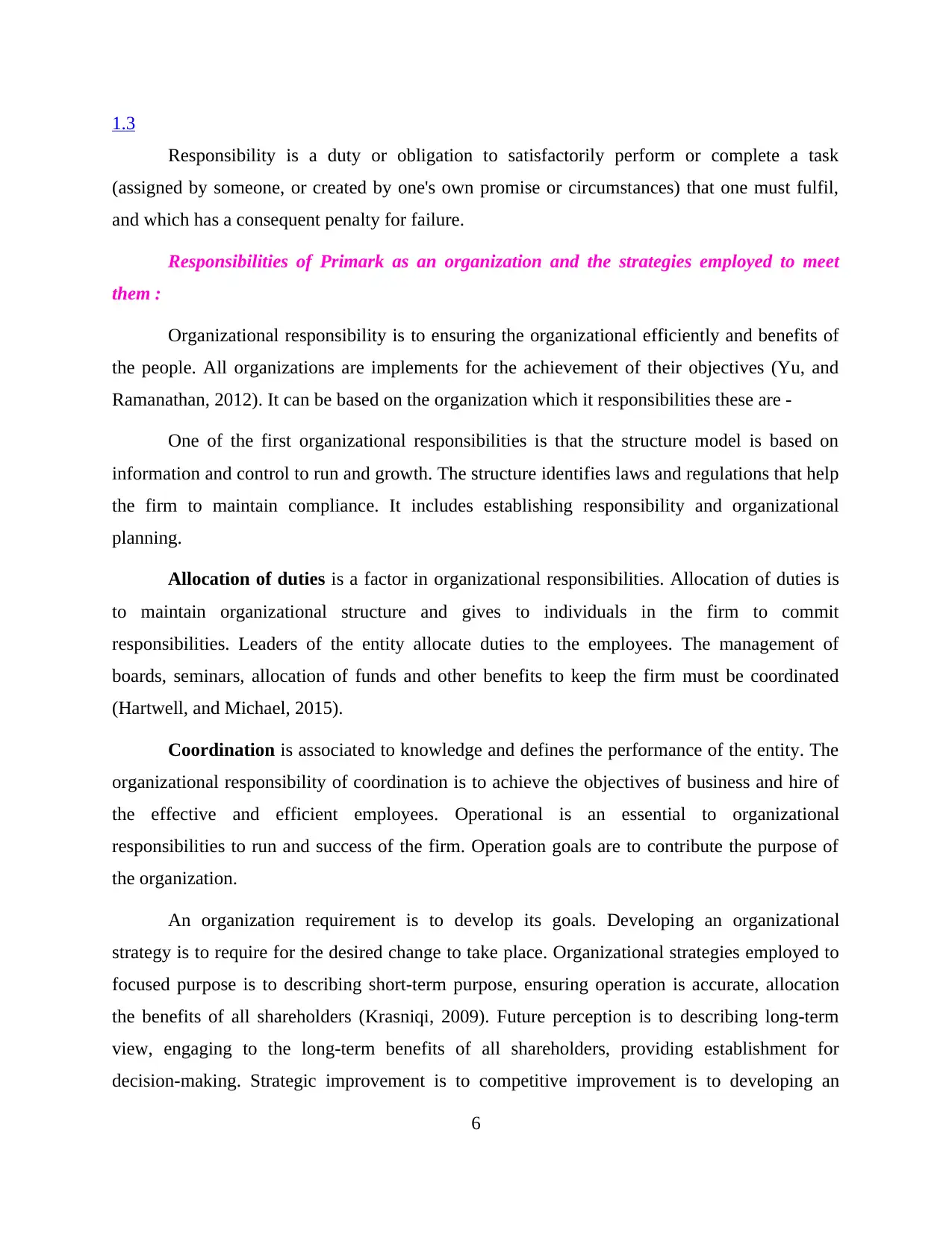
1.3
Responsibility is a duty or obligation to satisfactorily perform or complete a task
(assigned by someone, or created by one's own promise or circumstances) that one must fulfil,
and which has a consequent penalty for failure.
Responsibilities of Primark as an organization and the strategies employed to meet
them :
Organizational responsibility is to ensuring the organizational efficiently and benefits of
the people. All organizations are implements for the achievement of their objectives (Yu, and
Ramanathan, 2012). It can be based on the organization which it responsibilities these are -
One of the first organizational responsibilities is that the structure model is based on
information and control to run and growth. The structure identifies laws and regulations that help
the firm to maintain compliance. It includes establishing responsibility and organizational
planning.
Allocation of duties is a factor in organizational responsibilities. Allocation of duties is
to maintain organizational structure and gives to individuals in the firm to commit
responsibilities. Leaders of the entity allocate duties to the employees. The management of
boards, seminars, allocation of funds and other benefits to keep the firm must be coordinated
(Hartwell, and Michael, 2015).
Coordination is associated to knowledge and defines the performance of the entity. The
organizational responsibility of coordination is to achieve the objectives of business and hire of
the effective and efficient employees. Operational is an essential to organizational
responsibilities to run and success of the firm. Operation goals are to contribute the purpose of
the organization.
An organization requirement is to develop its goals. Developing an organizational
strategy is to require for the desired change to take place. Organizational strategies employed to
focused purpose is to describing short-term purpose, ensuring operation is accurate, allocation
the benefits of all shareholders (Krasniqi, 2009). Future perception is to describing long-term
view, engaging to the long-term benefits of all shareholders, providing establishment for
decision-making. Strategic improvement is to competitive improvement is to developing an
6
Responsibility is a duty or obligation to satisfactorily perform or complete a task
(assigned by someone, or created by one's own promise or circumstances) that one must fulfil,
and which has a consequent penalty for failure.
Responsibilities of Primark as an organization and the strategies employed to meet
them :
Organizational responsibility is to ensuring the organizational efficiently and benefits of
the people. All organizations are implements for the achievement of their objectives (Yu, and
Ramanathan, 2012). It can be based on the organization which it responsibilities these are -
One of the first organizational responsibilities is that the structure model is based on
information and control to run and growth. The structure identifies laws and regulations that help
the firm to maintain compliance. It includes establishing responsibility and organizational
planning.
Allocation of duties is a factor in organizational responsibilities. Allocation of duties is
to maintain organizational structure and gives to individuals in the firm to commit
responsibilities. Leaders of the entity allocate duties to the employees. The management of
boards, seminars, allocation of funds and other benefits to keep the firm must be coordinated
(Hartwell, and Michael, 2015).
Coordination is associated to knowledge and defines the performance of the entity. The
organizational responsibility of coordination is to achieve the objectives of business and hire of
the effective and efficient employees. Operational is an essential to organizational
responsibilities to run and success of the firm. Operation goals are to contribute the purpose of
the organization.
An organization requirement is to develop its goals. Developing an organizational
strategy is to require for the desired change to take place. Organizational strategies employed to
focused purpose is to describing short-term purpose, ensuring operation is accurate, allocation
the benefits of all shareholders (Krasniqi, 2009). Future perception is to describing long-term
view, engaging to the long-term benefits of all shareholders, providing establishment for
decision-making. Strategic improvement is to competitive improvement is to developing an
6
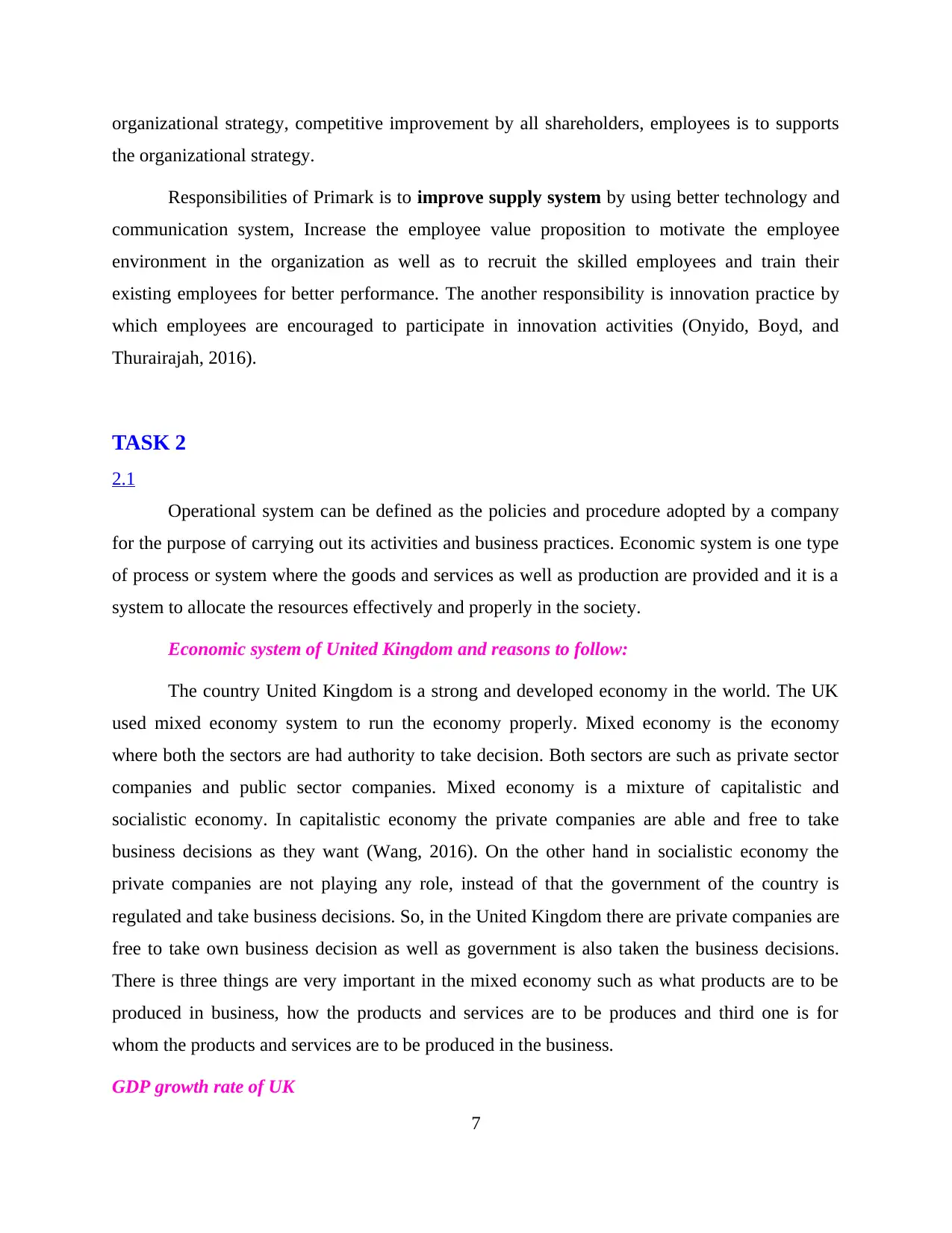
organizational strategy, competitive improvement by all shareholders, employees is to supports
the organizational strategy.
Responsibilities of Primark is to improve supply system by using better technology and
communication system, Increase the employee value proposition to motivate the employee
environment in the organization as well as to recruit the skilled employees and train their
existing employees for better performance. The another responsibility is innovation practice by
which employees are encouraged to participate in innovation activities (Onyido, Boyd, and
Thurairajah, 2016).
TASK 2
2.1
Operational system can be defined as the policies and procedure adopted by a company
for the purpose of carrying out its activities and business practices. Economic system is one type
of process or system where the goods and services as well as production are provided and it is a
system to allocate the resources effectively and properly in the society.
Economic system of United Kingdom and reasons to follow:
The country United Kingdom is a strong and developed economy in the world. The UK
used mixed economy system to run the economy properly. Mixed economy is the economy
where both the sectors are had authority to take decision. Both sectors are such as private sector
companies and public sector companies. Mixed economy is a mixture of capitalistic and
socialistic economy. In capitalistic economy the private companies are able and free to take
business decisions as they want (Wang, 2016). On the other hand in socialistic economy the
private companies are not playing any role, instead of that the government of the country is
regulated and take business decisions. So, in the United Kingdom there are private companies are
free to take own business decision as well as government is also taken the business decisions.
There is three things are very important in the mixed economy such as what products are to be
produced in business, how the products and services are to be produces and third one is for
whom the products and services are to be produced in the business.
GDP growth rate of UK
7
the organizational strategy.
Responsibilities of Primark is to improve supply system by using better technology and
communication system, Increase the employee value proposition to motivate the employee
environment in the organization as well as to recruit the skilled employees and train their
existing employees for better performance. The another responsibility is innovation practice by
which employees are encouraged to participate in innovation activities (Onyido, Boyd, and
Thurairajah, 2016).
TASK 2
2.1
Operational system can be defined as the policies and procedure adopted by a company
for the purpose of carrying out its activities and business practices. Economic system is one type
of process or system where the goods and services as well as production are provided and it is a
system to allocate the resources effectively and properly in the society.
Economic system of United Kingdom and reasons to follow:
The country United Kingdom is a strong and developed economy in the world. The UK
used mixed economy system to run the economy properly. Mixed economy is the economy
where both the sectors are had authority to take decision. Both sectors are such as private sector
companies and public sector companies. Mixed economy is a mixture of capitalistic and
socialistic economy. In capitalistic economy the private companies are able and free to take
business decisions as they want (Wang, 2016). On the other hand in socialistic economy the
private companies are not playing any role, instead of that the government of the country is
regulated and take business decisions. So, in the United Kingdom there are private companies are
free to take own business decision as well as government is also taken the business decisions.
There is three things are very important in the mixed economy such as what products are to be
produced in business, how the products and services are to be produces and third one is for
whom the products and services are to be produced in the business.
GDP growth rate of UK
7
⊘ This is a preview!⊘
Do you want full access?
Subscribe today to unlock all pages.

Trusted by 1+ million students worldwide
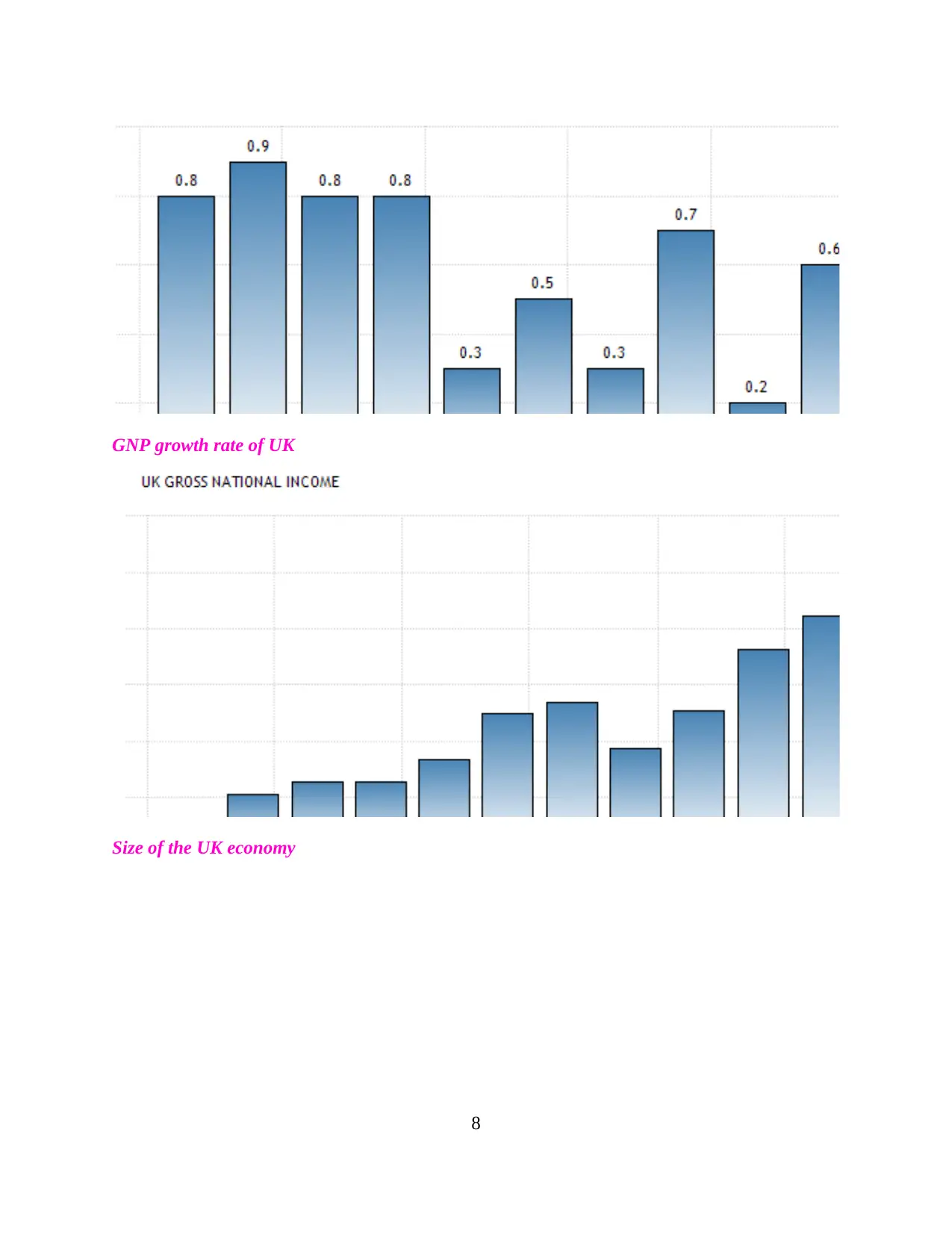
GNP growth rate of UK
Size of the UK economy
8
Size of the UK economy
8
Paraphrase This Document
Need a fresh take? Get an instant paraphrase of this document with our AI Paraphraser
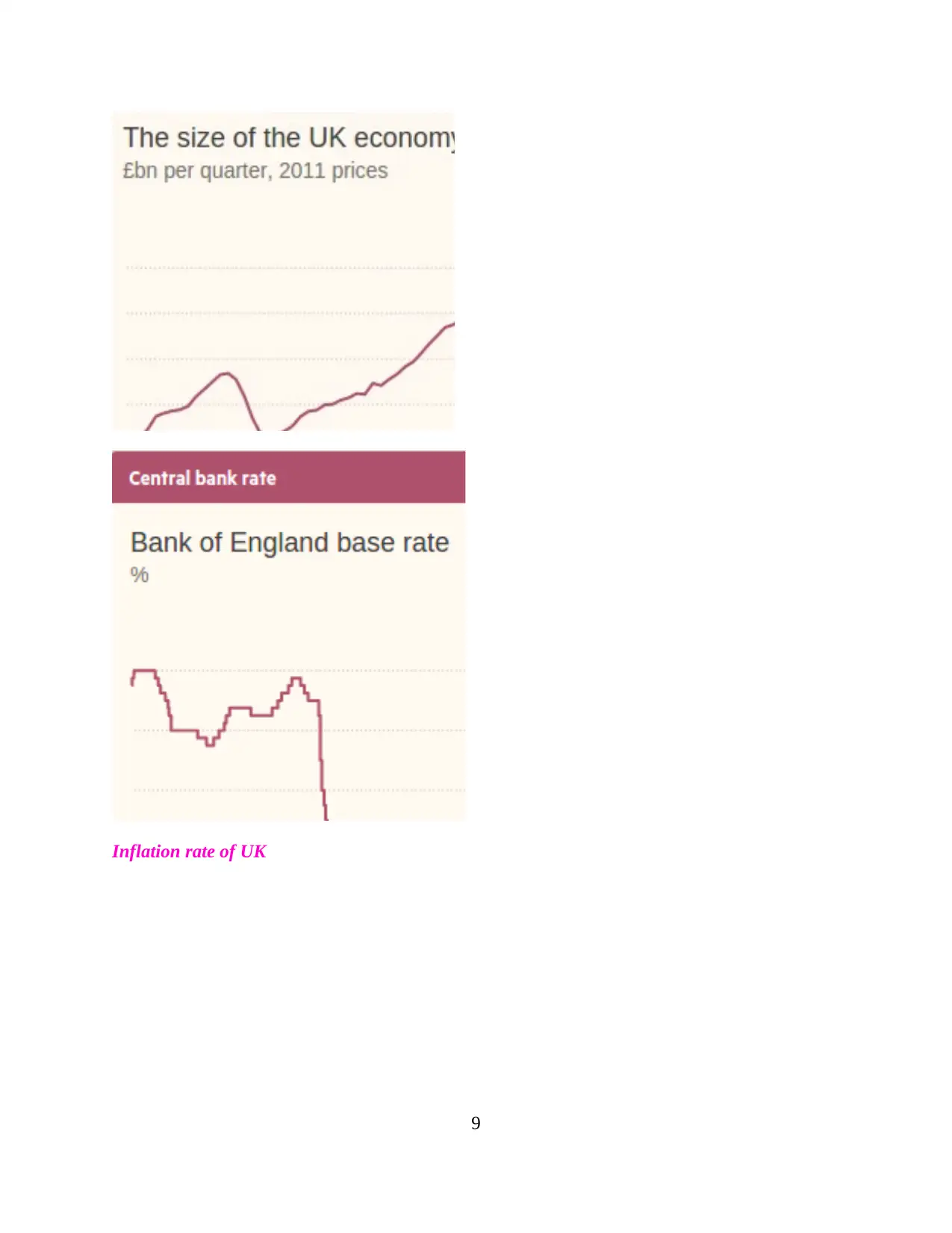
Inflation rate of UK
9
9
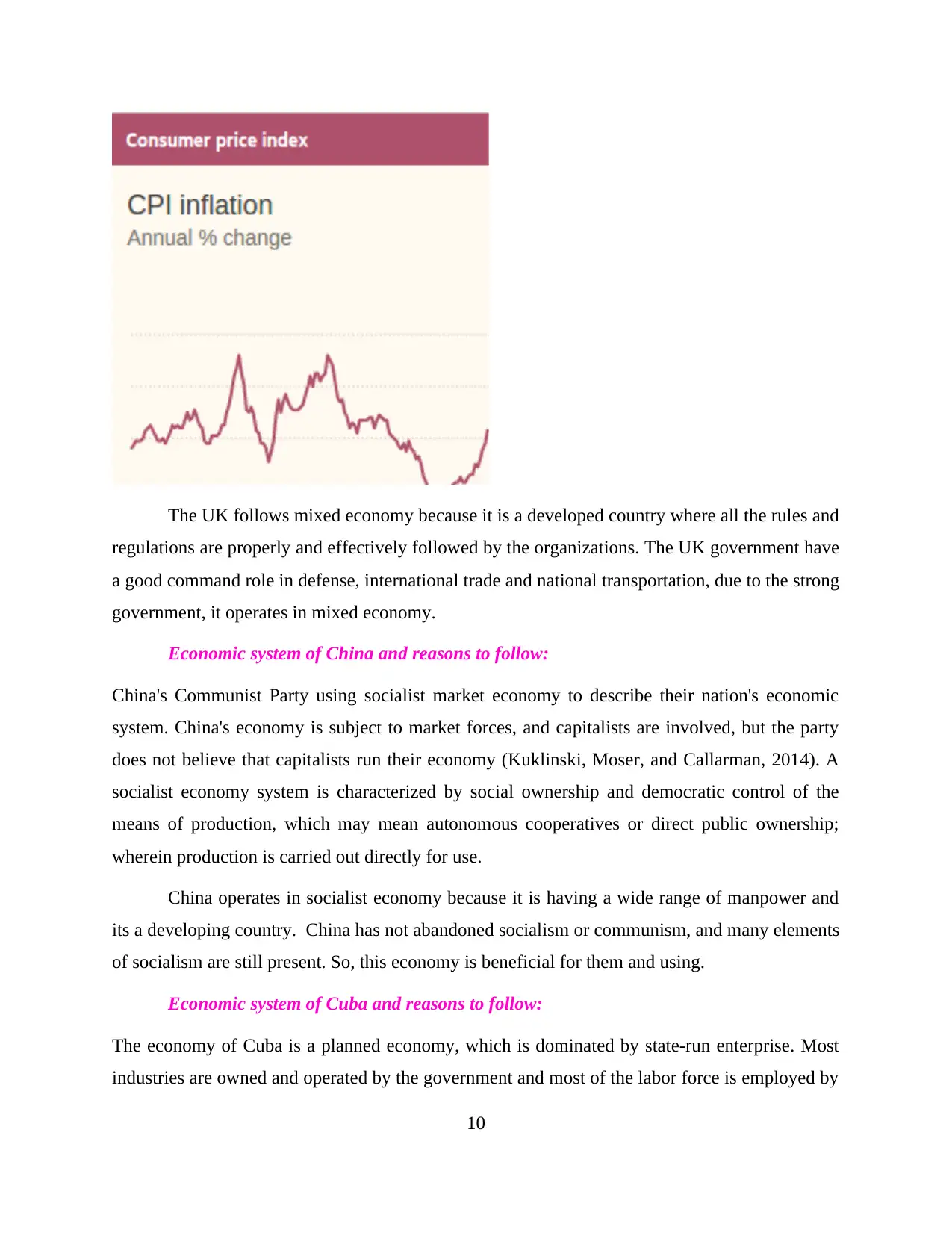
The UK follows mixed economy because it is a developed country where all the rules and
regulations are properly and effectively followed by the organizations. The UK government have
a good command role in defense, international trade and national transportation, due to the strong
government, it operates in mixed economy.
Economic system of China and reasons to follow:
China's Communist Party using socialist market economy to describe their nation's economic
system. China's economy is subject to market forces, and capitalists are involved, but the party
does not believe that capitalists run their economy (Kuklinski, Moser, and Callarman, 2014). A
socialist economy system is characterized by social ownership and democratic control of the
means of production, which may mean autonomous cooperatives or direct public ownership;
wherein production is carried out directly for use.
China operates in socialist economy because it is having a wide range of manpower and
its a developing country. China has not abandoned socialism or communism, and many elements
of socialism are still present. So, this economy is beneficial for them and using.
Economic system of Cuba and reasons to follow:
The economy of Cuba is a planned economy, which is dominated by state-run enterprise. Most
industries are owned and operated by the government and most of the labor force is employed by
10
regulations are properly and effectively followed by the organizations. The UK government have
a good command role in defense, international trade and national transportation, due to the strong
government, it operates in mixed economy.
Economic system of China and reasons to follow:
China's Communist Party using socialist market economy to describe their nation's economic
system. China's economy is subject to market forces, and capitalists are involved, but the party
does not believe that capitalists run their economy (Kuklinski, Moser, and Callarman, 2014). A
socialist economy system is characterized by social ownership and democratic control of the
means of production, which may mean autonomous cooperatives or direct public ownership;
wherein production is carried out directly for use.
China operates in socialist economy because it is having a wide range of manpower and
its a developing country. China has not abandoned socialism or communism, and many elements
of socialism are still present. So, this economy is beneficial for them and using.
Economic system of Cuba and reasons to follow:
The economy of Cuba is a planned economy, which is dominated by state-run enterprise. Most
industries are owned and operated by the government and most of the labor force is employed by
10
⊘ This is a preview!⊘
Do you want full access?
Subscribe today to unlock all pages.

Trusted by 1+ million students worldwide
1 out of 28
Related Documents
Your All-in-One AI-Powered Toolkit for Academic Success.
+13062052269
info@desklib.com
Available 24*7 on WhatsApp / Email
![[object Object]](/_next/static/media/star-bottom.7253800d.svg)
Unlock your academic potential
Copyright © 2020–2025 A2Z Services. All Rights Reserved. Developed and managed by ZUCOL.





